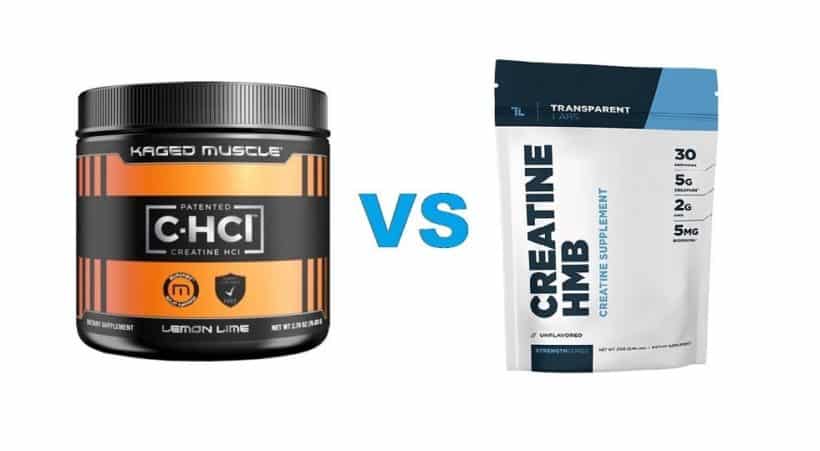Creatine HCL is the most popular form of creatine besides monohydrate, and for good reason.
So, why does anyone still take monohydrate anyways?
Because creatine monohydrate still rocks too, just in different ways.
Here we are going to cover all the up-to-date research on creatine HCL, typical supplements that contain it, and the best ways to take it. Then, we are going to compare creatine HCL to creatine monohydrate and determine which form is the best.
What is creatine hydrochloride?
Creatine hydrochloride is simply free-acid creatine with hydrochloric acid (2).
They really aren’t bonded together par say, rather they are just combined as a supplement.
The point to this is, that the hydrochloric acid will increase creatine solubility and absorption… Turns out, it does quite well.
Creatine HCL is a valid alternative to creatine monohydrate because it dissolves easier.
The reason why creatine HCL hasn’t ‘disappeared’ like so many other creatine forms, is because it solves a problem with creatine monohydrate.
That problem, is that creatine monohydrate doesn’t dissolve easily in water.
This is beneficial because of what can happen to undissolved creatine monohydrate…
This left over creatine monohydrate in your intestinal tract has the potential to do two irritable things (4).
- It draws in a great deal of water which causes you to bloat and have a soft, hydrated stool which reduces nutrient uptake.
- Bacteria in your gut may utilize creatine and heavily proliferate, creating imbalances that can reduce nutrient uptake.
This is why so many people report negative interactions with creatine monohydrate. Not to mention a long laundry list of impurities that have been FOUND in lesser quality creatine supplements (5).
Proper Creatine Monohydrate Supplementation is Side Effect Free
The side effects above that stem from poor creatine uptake suck. But, like most things in life, they don’t occur as an absolute law.
Meaning, the solution here is this…
First off, if you are taking creatine monohydrate, ensure that it is made by a reputable company.
To date, Creapure is the gold standard, and is used in many quality creatine supplements. They have a green logo that is normally on the back near the supplement facts of products.
Next, take your creatine properly. It really sucks that this step hasn’t been stressed further on product label directions, but we will give it to you here.
Hands down, when you take creatine you’ve got to make sure it dissolves. Dissolving means essentially going clear, so that you no longer see particles spinning around in the fluid.
To make this easier with something that doesn’t dissolve well like creatine monohydrate you can do one or both of the following: add more water, or heat the water. Both of these methods allow creatine monohydrate to dissolve better.
Back to Creatine HCL Supplementation
Creatine HCL dissolves incredibly fast and easily compared to creatine monohydrate.
Since creatine dissolves so easily, and therefor uptakes into the body easily – many supplement companies that make creatine HCL say that you need as little as 1/5 the amount compared to monohydrate.
Evidence supporting creatine hydrochloride use
We’re not very fond of animal studies, so here is what we found in men and women:
- Boise State participants taking 4 grams of creatine hydrochloride significantly increased the number of sets they could lift during 7 days of supplementation (6).
- Creatine supplementation in men and women resulted in significant leg-press improvements, while the beneficial boost from creatine hydrochloride as more visible in female participants (7).
Creatine Monohydrate Vs Creatine HCL Supplementation – Our Opinion
Both creatine monohydrate and creatine HCL work. While companies claim that you need way less creatine HCL than monohydrate, we still prefer taking more than 1/5 the monohydrate dose.
When it comes down to it, this is how we partition creatine monohydrate and creatine HCL.
- Creatine HCL is awesome to take pre workout without stimulants.
- Creatine Monohydrate is awesome to take at home after your gym session/with meals in warm water.
Under normal conditions, the BWSB staff has no problem taking both creatine HCL and monohydrate in this manner. It all comes down to schedule, ease, and what else we are taking. That’s why you will find a monohydrate as our top creatine supplement, despite creatine HCLs own unique advantages.
For instance, if we are taking a pre workout like Stim-Free by transparent labs which contains 3 grams of creatine HCL, then we may take another 1-2 grams of monohydrate with our post workout meal to top things off (for aggressive training weighing in at over 190 lbs).
On the other hand, if we are not taking a pre workout at all, or taking a stimulant pre workout that has little to no creatine, then we would take 5 grams of creatine monohydrate with our post workout meal.
This is all personal preference, and you can trial and error to find out what works best for your body and lifestyle.
